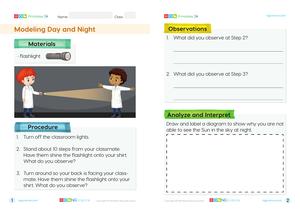Begin the lesson by introducing the concept of Earth's rotation using a simple analogy: 'Think of the Earth as a big spinning ball!' This helps students visualize how day and night occur.
Go to the LessonLearning Objectives
- Understand that the Earth rotates on its axis, causing day and night.
- Recognize that one full rotation of the Earth takes 24 hours.
- Identify the pattern of day and night resulting from Earth's rotation.
Introduction and Hook
Use a globe and flashlight to demonstrate how Earth's rotation causes day and night. This visual aid will engage students and provide a tangible understanding of the concept.
Direct Instruction
Explain the Earth's rotation on its axis and how it results in day and night. Highlight that one full rotation takes 24 hours.
Guided Exploration
Encourage students to observe and discuss the pattern of day and night in their daily lives. Ask them to share experiences of sunrise and sunset.
Hands-On Activity
Conduct a hands-on activity where students use a flashlight and globe to simulate the Earth's rotation and observe the changes in light and shadow.
Independent Practice
Assign students to observe the sky at different times of the day and record their observations in a journal. Encourage them to note changes in light and shadow.
Check for Understanding
Conduct a class discussion to review the key concepts of Earth's rotation and its impact on day and night. Ask students to share their observations and insights.
Review and Reflection
Reflect on the lesson by asking students to write a short paragraph about what they learned regarding Earth's rotation and its effects.
Encourage students to think about how the concept of day and night affects their daily routines and activities.
Assessment and Extension
Administer the 'Review – Earth and Space Patterns' assessment to evaluate students' understanding of the lesson's key concepts.
Try the Quiz






